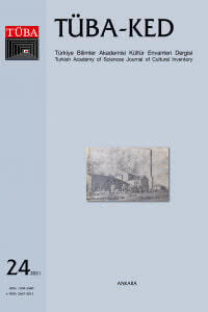GELENEKSEL ANTAKYA KONUTUNDA KATMANLAŞMA İZLERİNİN DEĞERLENDİRİLMESİ
Antakya, Geleneksel Konut, Katmanlaşma, Koruma, Restitüsyon.
EVALUATING THE TRACES OF LAYERS IN A TRADITIONAL ANTAKYA HOUSE
Antakya, Traditional House, Layers, Conservation, Restitution,
___
- BAKIRER, Ö., 1982. “Mimarlık Tarihi Araştırmalarında Belgelerin Katkıları”, T.C. Kültür ve Turizm Bakanlığı 1. Milli Kültür Şürası, Sayı:36.
- BELGE, B., 2017. “Planlama Sürecine Kentsel Arkeolojik Değerlerin Dâhil Edilmesi Sorunsalı: Tarsus Tarihi Kent Merkezi”, ODTÜ Mimarlık Fakültesi Dergisi, Sayi 34, No. 2, sy. 59-91.
- BİLGİN ALTINÖZ, G.,1996. Urban Archaeology as the Basis for the Studies on the Future of the Town; Case Study: Bergama, Yayınlanmamış Yüksek LisansTezi, ODTÜ Mimarlık Fakültesi, Restorasyon Lisansüstü Programı, Ankara.
- BİLGİN ALTINÖZ, G., 2002. Assessment of Historical Stratification in Multi-layered Towns as a Support for Conservation Decision-Making Process; A Geographic Information Systems (GIS) Based Approach. Case Study: Bergama, Yayınlanmamış Doktora Tezi, ODTÜ Mimarlık Fakültesi, Restorasyon Lisansüstü Programı, Ankara.
- BİLGİN ALTINÖZ, G., 2006. Çok Katmanlı Kentteki Tarihsel Katmanlaşmayı Çözümlemek: Kent Arkeolojisi, Erişim Yeri: http://www. metropolistanbul.com
- ÇELEBİ, Y., 1982. “Bir Grup Eski Antakya Evi”, Türk Etnografya Dergisi, Kültür ve Turizm Bakanlığı Eski Eserler ve Müzeler Genel Müdürlüğü Yayınlaro, Sayı: XVII, Ankara.
- DEMİR, A., 1996. Through the Ages Antakya, Akbank Publications, İstanbul.
- DEMİR, A., 2004, “The Urban Pattern of Antakya: Streets and Houses”, in: B. Cabouret – P.-L. Gatier – C. Saliou (eds.), Antioche de Syrie Histoire, images et traces de la ville antiquet. TOPOI Supplément 5, 221-238.
- KARA, A., 2014. “19. Yüzyılda Antakya”, Osmanlı Belgeleri Işığında Antakya, ed. Ergün, A., Terzi, M.A., Hatay Büyükşehir Belediyesi Kültür Yayınları, No. 2, 57-75.
- PAMİR, H., SEZGİN, N., 2016. “The Sundial and Convivium Scene on the Mosaic from the Rescue Excavation in a Late Antique House of Antioch”, Adalya, No.XIX, 251-281.
- PINNON, P., 2004. “Survivances et transformations dans la topographie d’Antioche apres l’Antiquité”, in: B. Cabouret – P.-L. Gatier – C. Saliou (eds.), Antioche de Syrie Histoire, images et traces de la ville antiquet. TOPOI Supplément 5, 191-219.
- RİFAİOĞLU, M.N., 2012. An Enquiry into the Definition of Property Right in Urban Conservation: Antakya (Antioch) from 1929 title deeds and cadastral plans, Yayınlanmamış Doktora Tezi, Ortadoğu Teknik Üniversitesi, Mimarlık Fakültesi, Restorasyon Lisansüstü Programı, Ankara.
- RİFAİOĞLU, M.N., 2014. “The Historic Urban Core of Antakya under the Influence of the French Mandate, and Turkish Republican Urban Conservation and Development Activities”, Megaron Dergisi, Yıldız Teknik Üniversitesi, Mimarlık Fakültesi, İstanbul.
- RİFAİOĞLU, M.N.,2015. “Antakya Tarihi Kent Dokusu Çıkmaz Sokaklarının Mekânsal-Kültürel Değerleri ve Koruma Sorunsalı”, Mimarlık Dergisi, TMMOB Mimarlar Odası Ankara Şubesi Yayınları, Sayı 381,53-58.
- SAUVAGET, J., 1935. “Le Plan de Laodicée-Sur-Mer, Institut Français de Damas”, Bulletin d’Etudes Orientales, vol 4, Cairo.
- ULUSOY BİNAN, D., 2016. “Türkiye’de Çok Katmanlı Yerleşimlerde TanımlamaKoruma Yaklaşımı ve Öneriler: Bergama Örneği”, Tasarım + Kuram, 9 (16), 1-26.
- WEULERSSE J., 1934. “Antioche Essai de Geographie Urbaine”, Bulletin d’etudes orientales, T.4, 27-79.
- YERASİMOS, S. 1996. “Tanzimat’ın Kent Reformları Üzerine”, Modernleşme Sürecinde Osmanlı Kentleri, Dupont, P., Georgeon, F. (eds.), Tarih Vakfı Yurt Yayınları, İstanbul.
- ISSN: 1304-2440
- Yayın Aralığı: 2
- Başlangıç: 2003
- Yayıncı: Türkiye Bilimler Akademisi
YENİDEN İŞLEVLENDİRİLEN BİR GELENEKSEL KONUT; TOKAT VASFİ SÜSOY EVİ
EMİNE SAKA AKIN, Aygün KALINBAYRAK ERCAN, Sadakat Safiyye MUMCUOĞLU, ELİF YAPRAK BAŞARAN
ÖNEMLİ BİR DENİZCİLİK KÜLTÜR MİRASI: TÜRKİYE’NİN EGE KIYILARINDAKİ DENİZ FENERLERİ
ÖZGE BAŞAĞAÇ, AYŞE GÜLİZ BİLGİN ALTINÖZ
Deniz HEKİMOĞLU, AYŞEGÜL ALTINÖRS ÇIRAK
BATI ANADOLU’DA ESKİ ZEYTİNYAĞI İŞLİKLERİ VE MİMARİ ÖZELLİKLERİ
GİRESUN, ŞEBİNKARAHİSAR İLÇESİNİN KÜLTÜREL MİRASI: TAMZARA BEZİ
ARZU ARSLAN, FATMA NUR BAŞARAN
YENİ BULGULAR IŞIĞINDA TİRE BEDESTENİ
